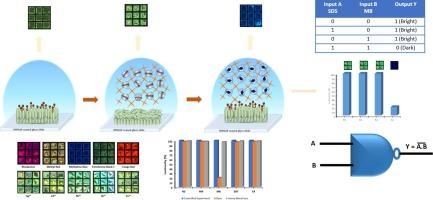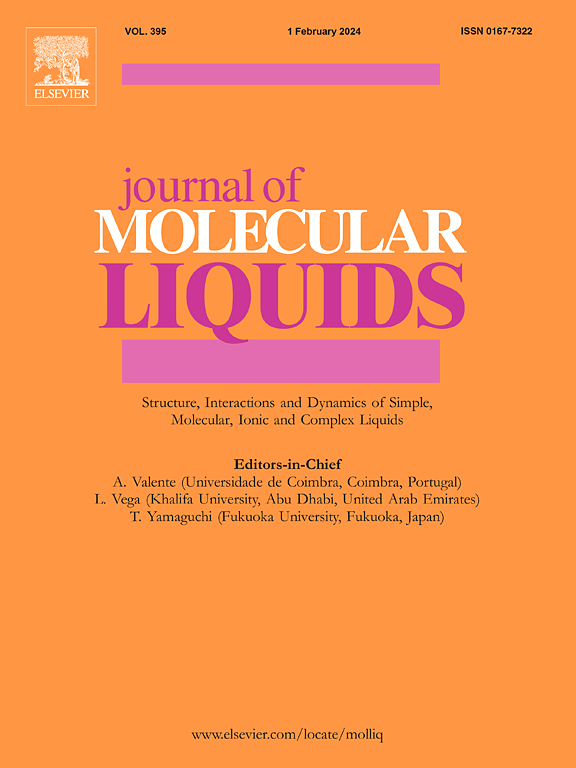Development of a liquid crystal-based sensor utilizing EDTA-cyclodextrin polymer for real-time optical detection of methylene blue in natural water samples
IF 5.3
2区 化学
Q2 CHEMISTRY, PHYSICAL
引用次数: 0
Abstract
The discharge of dyes in industrial wastewater poses significant environmental and health risks when released into natural water resources. In this study, we report the development of an EDTA-crosslinked cyclodextrin polymer (ECDP)-based sensor for the real-time, naked-eye detection of hazardous methylene blue (MB) dye in aqueous solutions and natural water samples. The sensor functions via a competitive host–guest inclusion mechanism involving sodium dodecyl sulphate (SDS) and ECDP, which modulates the alignment of liquid crystals (LCs). Initially, SDS induces homeotropic ordering at the fluid interface, but when complexed with ECDP, it causes a tilted LC alignment. Upon the introduction of MB, SDS is displaced from the ECDP cavity and re-adsorbs at the LC/aqueous interface, triggering an orientational transition from tilted to homeotropic. This transition is clearly observed as a distinct bright-to-dark shift under crossed polarizers. The host–guest (ECDP/MB) inclusion complexation mechanism was further confirmed by FT-IR, XRPD, and DSC analyses. The developed sensor exhibits high selectivity for MB in dye-contaminated natural water samples and sensitivity to MB concentrations upto 0.10 mM. This study demonstrates the potential of cyclodextrin-based polymers for liquid crystal sensing applications, offering promising pathways for future developments in environmental monitoring.

利用 EDTA 环糊精聚合物开发液晶传感器,用于实时光学检测天然水样中的亚甲基蓝
工业废水中的染料排放到天然水资源中会对环境和健康造成严重危害。在本研究中,我们报告了一种基于 EDTA 交联环糊精聚合物(ECDP)的传感器的开发情况,该传感器用于实时裸眼检测水溶液和天然水样中的有害亚甲基蓝(MB)染料。该传感器通过十二烷基硫酸钠(SDS)和 ECDP 的竞争性主-客包含机制发挥作用,后者可调节液晶(LC)的排列。起初,SDS 会在流体界面诱导各向同性有序排列,但当与 ECDP 复合时,则会导致液晶倾斜排列。引入 MB 后,SDS 会从 ECDP 的空腔中移出,并重新吸附在 LC/水界面上,从而引发从倾斜到各向同性的取向转变。在交叉偏振镜下,可以清楚地观察到这种转变,即明显的由亮到暗的转变。FT-IR 、XRPD 和 DSC 分析进一步证实了主-客(ECDP/MB)包合物复合机制。所开发的传感器对受染料污染的天然水样中的甲基溴具有很高的选择性,对浓度高达 0.10 mM 的甲基溴具有很高的灵敏度。这项研究证明了环糊精基聚合物在液晶传感应用方面的潜力,为环境监测领域的未来发展提供了广阔的前景。
本文章由计算机程序翻译,如有差异,请以英文原文为准。
求助全文
约1分钟内获得全文
求助全文
来源期刊

Journal of Molecular Liquids
化学-物理:原子、分子和化学物理
CiteScore
10.30
自引率
16.70%
发文量
2597
审稿时长
78 days
期刊介绍:
The journal includes papers in the following areas:
– Simple organic liquids and mixtures
– Ionic liquids
– Surfactant solutions (including micelles and vesicles) and liquid interfaces
– Colloidal solutions and nanoparticles
– Thermotropic and lyotropic liquid crystals
– Ferrofluids
– Water, aqueous solutions and other hydrogen-bonded liquids
– Lubricants, polymer solutions and melts
– Molten metals and salts
– Phase transitions and critical phenomena in liquids and confined fluids
– Self assembly in complex liquids.– Biomolecules in solution
The emphasis is on the molecular (or microscopic) understanding of particular liquids or liquid systems, especially concerning structure, dynamics and intermolecular forces. The experimental techniques used may include:
– Conventional spectroscopy (mid-IR and far-IR, Raman, NMR, etc.)
– Non-linear optics and time resolved spectroscopy (psec, fsec, asec, ISRS, etc.)
– Light scattering (Rayleigh, Brillouin, PCS, etc.)
– Dielectric relaxation
– X-ray and neutron scattering and diffraction.
Experimental studies, computer simulations (MD or MC) and analytical theory will be considered for publication; papers just reporting experimental results that do not contribute to the understanding of the fundamentals of molecular and ionic liquids will not be accepted. Only papers of a non-routine nature and advancing the field will be considered for publication.
 求助内容:
求助内容: 应助结果提醒方式:
应助结果提醒方式:


